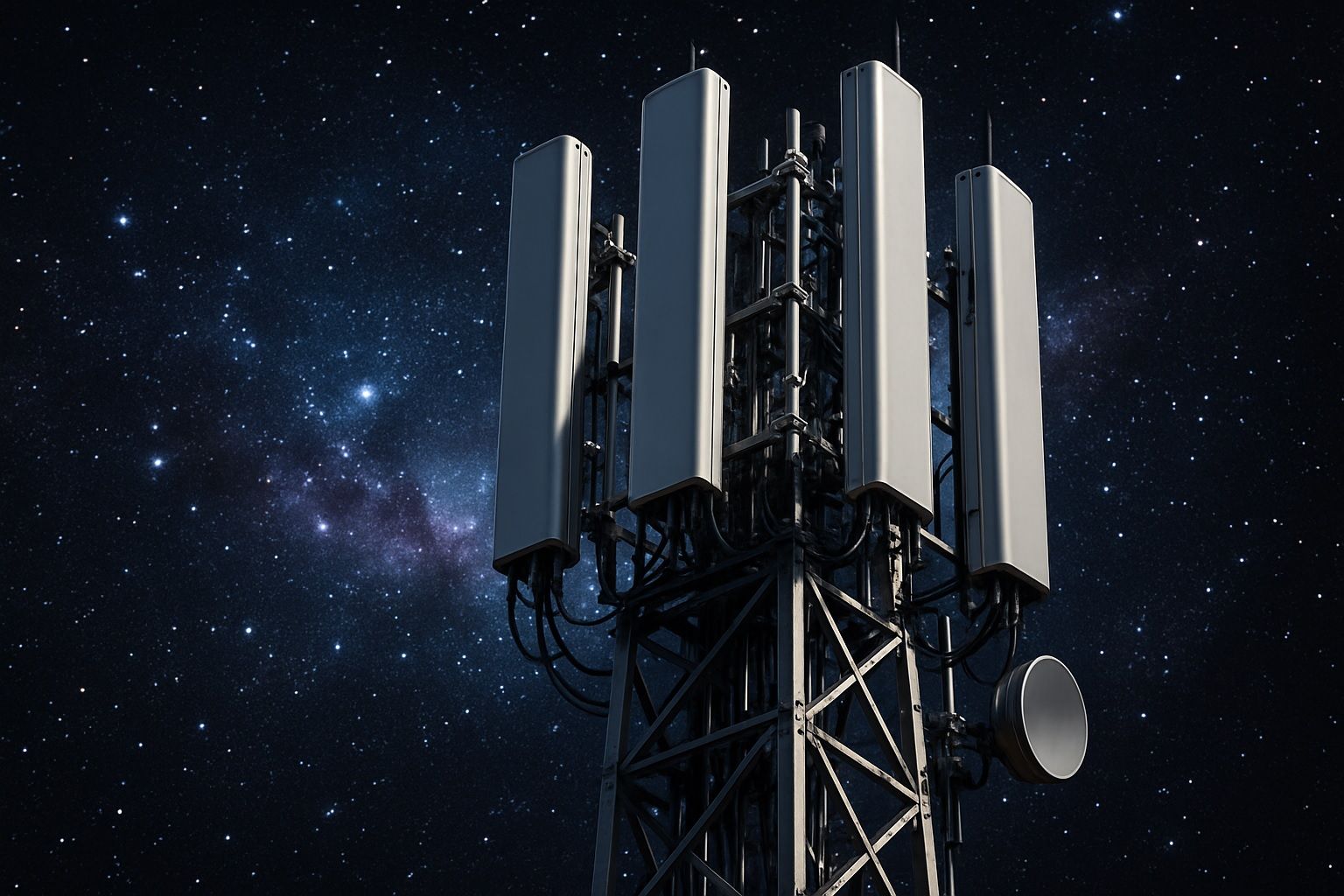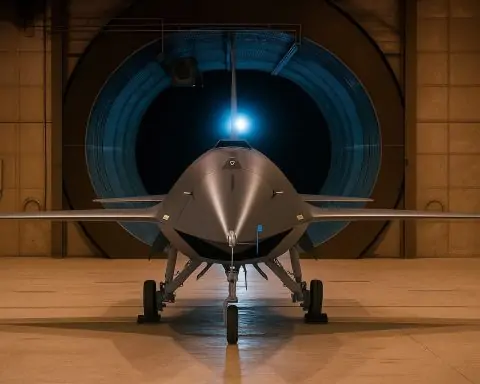- France 2030, launched in 2021 as a €30 billion investment plan, prioritizes converging 5G with space through end-to-end NTN pilots.
- The European Commission’s IRIS² programme, approved in 2022, will deploy hundreds of satellites (about 270 LEO and 18 MEO) and be fully operational by 2030, with Eutelsat as a prime contractor.
- In early 2025, Eutelsat announced the world’s first 5G NTN trial using the OneWeb LEO constellation at ~1200 km altitude, linking a standard 5G signal to the core network.
- The pilot used Airbus-built LEO satellites, a MediaTek 5G-NTN test chipset, an ITRI prototype gNB, and a Sharp phased-array antenna, all aligned with 3GPP Release-17 NTN standards.
- The trial demonstrated a stable, broadband 5G connection from an NTN-enabled device to the core network with the LEO acting as the in-between cell tower.
- Engineers validated handovers between two moving LEO satellites to maintain service continuity as satellites passed in and out of view.
- In March 2025, Ericsson, Thales Alenia Space, and Qualcomm announced a 3GPP-compliant 5G NR NTN call via a simulated LEO link in France, reproducing delay and Doppler effects.
- Lab tests showed a standard 5G smartphone can connect to a satellite overhead without an external dish, validating the concept of satellite-augmented 5G in real-world conditions.
- June 2025 saw Orange sign a multi-year agreement with Eutelsat to incorporate OneWeb LEO satellite links into its global 5G network for backhaul and remote coverage.
- The program is designed to broaden satellite-based 5G coverage, support sovereign connectivity, and position Europe to lead NTN development and 6G concepts through IRIS² and France 2030.
The push to bridge 5G and space is rapidly becoming a strategic priority for France and Europe. By integrating non-terrestrial networks (NTN) – essentially satellite communication links – into terrestrial 5G infrastructure, operators hope to achieve truly global connectivity. Under the France 2030 investment plan, an ambitious end-to-end NTN pilot has been launched, leveraging dual low-Earth orbit (LEO) satellites to extend 5G coverage far beyond the reach of cell towers. Recent demonstrations under this program have showcased how a 5G signal can be beamed from Earth to orbit and back, seamlessly connecting devices in remote areas via satellite [1] [2]. This report delves into France’s national objectives for 5G-space convergence, the latest updates on the pilot project, insights from industry experts, and the broader implications for global telecom and space-based internet services.
France 2030 and the NTN Vision
Launched in 2021 as a €30 billion investment blueprint, France 2030 seeks to transform key sectors of the economy and secure French technological sovereignty by the end of the decade [3]. One of its ten flagship objectives is to “play our role in new space adventures”, underlining the country’s commitment to New Space innovation and satellite-enabled services [4]. Within this framework, extending 5G coverage via satellites has emerged as a priority. French policymakers view NTN capabilities as vital for digital inclusion (connecting rural “not-spots” and overseas territories), geopolitical and data sovereignty, and network resilience in emergencies [5] [6]. In practical terms, this means ensuring that future 5G (and even 6G) networks can rely on French and European satellite constellations, rather than exclusively on foreign ones like SpaceX’s Starlink.
This strategic thrust aligns with Europe’s broader plans. The European Commission’s IRIS² programme – a €10+ billion secure connectivity constellation approved in 2022 – places satellite networks “at the core” of extending internet and 5G coverage across the continent [7]. IRIS² will consist of hundreds of LEO and medium-Earth orbit (MEO) satellites (roughly 270 LEO + 18 MEO) and is scheduled to be fully operational by 2030 [8]. French actors are heavily involved: Eutelsat (France’s satellite operator) was selected as one of IRIS²’s prime contractors, alongside partners like Thales Alenia Space, Airbus Defence and Space, Orange, and others [9]. As Eutelsat CEO Eva Berneke put it, “IRIS² will be an alternative to American constellations like Starlink and Chinese ones. For Eutelsat, this constellation brings additional capacity in low orbit, in synergy with our OneWeb constellation” [10] [11]. In short, France’s 2030 vision and Europe’s IRIS² are convergent: both aim to integrate satellites into 5G to guarantee continental connectivity and autonomy.
The End-to-End NTN Pilot: Two LEO Satellites in Action
At the heart of France 2030’s space connectivity effort is an end-to-end NTN pilot project that demonstrates 5G links via dual LEO satellites. In early 2025, this pilot achieved a major milestone: French satellite operator Eutelsat announced the world’s first trial of a 5G NTN connection using LEO satellites. In the test, a standard 5G signal was sent through OneWeb satellites – in low Earth orbit ~1200 km above – down to a 5G ground network [12]. The trial leveraged OneWeb’s constellation (now part of Eutelsat Group) along with advanced 5G hardware: the LEO satellites built by Airbus, a MediaTek 5G-NTN test chipset, a prototype 5G base station (gNB) from Taiwan’s ITRI, and a Sharp phased-array antenna [13] [14]. All components complied with the latest 3GPP Release-17 NTN standards, meaning the setup mirrored real-world 5G as closely as possible. The result was a success – a stable broadband connection directly between an NTN-enabled 5G device and the core network, with the LEO satellite acting as the cell tower in between [15].
“LEO-enabled services are becoming an integral technology for global telco operators,” said Cyril Dujardin, head of Eutelsat’s connectivity business [16]. Indeed, this French-led demo was significant as the first to use an operational LEO constellation and standard 5G hardware in tandem [17] [18]. It proved that a 5G user terminal – e.g. a smartphone or customer premises antenna – can connect through space to the internet, attaining high throughput and low latency akin to terrestrial service. OneWeb’s existing LEO network (over 600 satellites) provided the orbital link, and engineers even validated handover scenarios between satellites to ensure continuity of service as one satellite passed out of view and another took over (hence the use of dual satellites to test seamless coverage). The ability to maintain a live 5G connection across two moving satellites was a key proof-of-concept for the pilot’s “end-to-end” NTN vision, showing that future users could roam between terrestrial 5G and satellite coverage without drops.
Notably, this in-orbit pilot builds on prior lab trials by French industry. In March 2025, Ericsson, Thales Alenia Space, and Qualcomm announced they had jointly made a 5G phone call via a simulated LEO satellite link in France [19]. Using a French test lab, they established a 3GPP-compliant 5G NR NTN connection that emulated real LEO satellite conditions (including the signal delay and Doppler shift caused by a fast-moving satellite) [20]. “This successful 5G NTN call isn’t just a technological breakthrough; it showcases the practical viability of integrating satellite tech within existing terrestrial frameworks,” remarked Ericsson’s EVP Fredrik Jejdling, highlighting that the goal is “ubiquitous connectivity” and bridging the digital divide by making “reliable communication available to every corner of the world” [21]. The French team rigorously tested whether a standard 5G device could stay connected without any special satellite dish, even in the middle of an ocean or desert. The answer was yes – if a LEO satellite is overhead, a 5G phone could latch onto it just as it would to a remote cell tower [22]. This lab validation set the stage for the live dual-satellite pilot, essentially de-risking the technical challenges before in-orbit trials.
The technical significance of these milestones cannot be overstated. They mark the first time a 5G New Radio signal was sent to actual LEO satellites and back using off-the-shelf 5G components. The pilot confirmed that 3GPP’s new NTN specifications work outside theory: timing and Doppler compensation in the radio wave were handled; the network recognized the satellite link as just another “cell”; and user traffic (voice, video, data) flowed with manageable latency [23]. According to Eutelsat, this paves the way for deploying satellite-to-phone 5G in the coming years, which “will lower the cost of internet access and expand satellite broadband for 5G devices” worldwide [24]. In other words, once such NTN capability is commercially scaled, someone in a rural village, aboard a ship, or in a disaster zone could get 5G service on a regular phone via satellite – dramatically widening the reach of mobile networks.
Key Partners: CNES, Thales, Orange, and More
Executing a complex end-to-end NTN pilot requires a constellation of partners. A central orchestrator is the French Space Agency (CNES), which under France 2030 has been tasked with fostering emerging space telecom technologies. CNES provides strategic direction and R&D funding in tandem with other agencies (often via the European Space Agency’s programs) to support projects like this pilot [25] [26]. Through France 2030’s space budget, CNES and the French government launched calls for proposals to stimulate innovation in satellite communications, much as they did for Earth observation and in-orbit servicing. The NTN pilot’s realization owes in part to CNES-backed initiatives – for example, CNES was instrumental in previous “Space for 5G” efforts and has channeled France 2030 grants to startups working on 5G constellations [27] [28]. Bpifrance, the French public investment bank, is also supporting startups in this domain. In 2024, a Paris-region startup Constellation Technologies & Operations (CTO) raised €9.3 million (with French Tech Seed funding under France 2030) to develop an LEO satellite network for 5G [29] [30]. CTO is partnering with academic labs (IMT), the start-up Greenerwave (specialized in antenna meta-materials), and the aerospace research agency ONERA on a pilot using two very-low-orbit satellites and 5G millimeter-wave (mmWave) links [31] [32]. This illustrates how France 2030 is nurturing a broader ecosystem beyond just the big players – ensuring new ventures contribute innovative solutions (like advanced antennas or network orchestration) to the NTN goal.
On the industrial side, Thales Alenia Space has been a key partner and beneficiary of France’s NTN drive. Thales (jointly with Italy’s Leonardo) not only builds satellites but has years of expertise in satellite telecommunications payloads. The company proudly notes it “was at the heart of initiatives to seamlessly integrate satellite comms into 5G, including 3GPP standardization”, and has designed its new satellite payloads with 5G NTN services in mind [33]. Under an ESA contract partly supported by France, Thales Alenia Space is also leading the LEO-PNT project (a LEO satellite navigation demo) – which, while focused on positioning, complements the know-how for operating LEO constellations that can also carry comms [34] [35]. For the 5G NTN pilot, Thales provided engineering of the space segment and adaptation of a 5G radio payload for use on a low-orbiting platform [36]. “By combining Thales Alenia Space’s expertise in space technologies with Ericsson’s leadership in 5G networks and Qualcomm’s advanced chipsets, we are making significant headway towards seamless integration of terrestrial and NTN networks,” said Hervé Derrey, CEO of Thales Alenia Space [37]. The pilot indeed saw a prototype Thales payload (in this case, OneWeb’s bent-pipe broadband payload, manufactured by the Airbus/OneWeb joint venture) successfully serve a 5G signal.
France’s leading mobile operator Orange is another crucial partner, representing the end-user telecom perspective. Orange’s role is to integrate satellite connectivity into mainstream services – essentially acting as the bridge between the satellite network and millions of French (and European) mobile users. In June 2025, Orange announced a multi-year agreement with Eutelsat to incorporate OneWeb LEO satellite links into its global 5G network for backhaul and remote coverage [38] [39]. The deal will allow Orange’s enterprise, government, and rural customers to tap into “high throughput, low-latency, resilient and sovereign services” provided via LEO satellites as a complement to terrestrial 5G [40]. “It is of strategic importance for Orange to invest in [a] unique LEO European solution that provides best-in-class, resilient, tailored and sovereign digital connectivity services to serve our customers wherever they are,” explained Jean-Louis Le Roux, Orange’s EVP for International Networks [41]. Orange’s involvement ensures that the NTN pilot isn’t happening in a vacuum; rather, it is closely tied to real operator requirements and will be tested in carrier environments (for example, Orange can trial satellite handovers on its 5G test networks and validate that user experiences – like voice calls or video streaming – remain consistent [42] [43]). Orange’s participation also highlights France’s intent to keep its telecom industry competitive: by adopting satellite augmentation, French operators can promise 100% geographic coverage, an edge in both commercial offerings and critical services (defense, emergency communications, etc.).
Eutelsat itself, now merged with OneWeb, is a linchpin partner providing the space infrastructure for the pilot. The French government has shown strong support for Eutelsat’s pivot to LEO: in fact, France is set to double its stake in Eutelsat, investing around €300 million, as part of a capital raise to finance the OneWeb merger and the IRIS² build-out [44] [45]. This underscores how France 2030 funding is being deployed at the highest corporate level to ensure a sovereign LEO constellation under European control. With Eutelsat’s satellites and ground stations, the pilot can operate over France and beyond. Notably, Airbus Defence and Space – which mass-produced the OneWeb satellites in its Toulouse factory – and Qualcomm Technologies – which supplied test user equipment and NTN-compatible chipsets – are also vital contributors [46] [47]. Qualcomm’s engineers provided prototype 5G smartphones for the trial, proving that “future 5G smartphones will be able to access 5G NTN” with only software and chipset enhancements, and no external antennas [48]. This kind of collaboration between aerospace and semiconductor/telecom industries is exactly what France 2030 envisaged: breaking silos so that satellite systems are co-designed with network hardware and silicon from day one.
Finally, research institutions and startups add innovation at the edges. Besides the CTO startup mentioned, projects like “I-ANT” (led by Anywaves and funded by France 2030) are developing new antenna tech for small satellites [49]. The Institut Mines-Télécom and other French universities are deeply involved in NTN waveform research (including an “Networks of the Future” program under France 2030 focusing on non-terrestrial networks) [50]. Even the French military is interested – the Defense Ministry sees 5G NTN as a way to connect troops and assets globally with guaranteed security. In sum, the NTN pilot is backed by a who’s who of French and European space-tech players: CNES and ESA coordinating, Thales and Airbus building satellites, Orange and possibly other European operators integrating the service, Eutelsat providing orbit assets, and numerous smaller firms and labs contributing enabling technologies.
Bridging 5G and Space: Technical Breakthroughs and Challenges
The France 2030 NTN pilot is tackling head-on the technical challenges of merging a terrestrial cellular network with fast-moving satellites in orbit. One major breakthrough already achieved is demonstrating that a standard 5G New Radio (NR) signal can travel ~1200 km up to a LEO satellite and back with acceptable latency and signal quality. In the February 2025 Eutelsat-OneWeb test, engineers measured performance that met 5G quality-of-service levels – a feat enabled by LEO’s low latency (about ~50–70 ms one-way). By comparison, traditional geostationary satellites (~36,000 km away) impose latency around 600 ms, too high for real-time 5G applications. This is why France 2030’s pilot chose LEO satellites: their proximity to Earth dramatically reduces lag, making interactive services like video calls or even online gaming feasible via satellite [51] [52]. The trade-off, however, is that each LEO satellite covers a smaller footprint and moves quickly across the sky, necessitating a constellation for continuous coverage. The pilot’s use of dual satellites showed how a 5G connection could handover from one satellite to the next seamlessly – analogous to how your phone switches between cell towers when you drive, but at 28,000 km/h orbital speeds! Managing Doppler shifts (the apparent frequency change due to satellite motion) was a key part of the tests. Using 3GPP’s NTN algorithms, the network compensated for Doppler effects and timing offsets, so the satellite link appeared “normal” to the 5G core network [53] [54].
Another technical focus is the air interface and antennas. The pilot examined different frequency bands (OneWeb satellites currently use Ku-band, ~12–18 GHz, for user links). Future NTN might use even higher frequencies like Ka or Q/V bands, or 5G’s millimeter-wave bands around 26–40 GHz, to achieve high data throughputs. France-based research is looking at smart antennas that can fit on a smartphone or a car and electronically steer beams toward satellites. For instance, the startup Greenerwave’s involvement hints at metasurface antennas – low-profile panels that can steer radio beams without mechanical parts [55] [56]. Such tech will be crucial for user devices to track LEO satellites passing overhead. The pilot also validated the use of network slicing and beam hopping: slicing would let the satellite network dedicate bandwidth to specific services (e.g., emergency responders), while beam hopping allows a single satellite to rapidly switch its coverage between areas to meet demand. Although not all these features were fully tested in this initial pilot, the end-to-end setup was a sandbox to try them. According to Ericsson, the test system explored “critical components such as handling delays, Doppler effects, and ensuring seamless satellite handovers”, all crucial for maintaining communication integrity in an NTN environment [57].
From a standards perspective, France 2030’s timing has been advantageous. 3GPP Release 17 (frozen in mid-2022) introduced formal support for Non-Terrestrial Networks in the 5G specs [58]. This includes provisions for adapting timing advance, power control, and even new waveform tweaks to cope with long distances. The French pilot is one of the first in the world to implement these standards end-to-end, which means the lessons learned feed directly into global 5G development. It effectively positions French and European firms at the forefront of NTN know-how. The collaboration between Qualcomm, Thales, and Ericsson was in fact “the world’s first publicly announced collaboration for 5G NTN based on 3GPP standards” when it started in 2022 [59]. By early 2025, they proved the concept, and shortly after, the live satellite trial took it further. This gives France and its partners a head-start in defining 6G as well – since 6G is expected to natively incorporate satellite and aerial platforms from the outset. “We are committed to further refinement of 5G/6G NTN technologies, aiming to introduce and scale 5G NTN on the market – from multi-orbit satellites including messaging, voice, and data, to make seamless communication a reality for everyone, everywhere,” the companies said in a joint statement [60]. In essence, the pilot is not just about 5G, but about architecting the networks of the future where terrestrial and non-terrestrial components operate as one.
Strategic and Global Implications
France’s end-to-end NTN pilot with LEO satellites carries significant implications for the global expansion of 5G, the future of space-based internet, and a host of commercial and defense applications. Firstly, if seamless 5G/satellite connectivity becomes a commercial reality, it could finally eliminate the world’s connectivity gaps. Even in 2025, billions of people live outside reliable mobile broadband coverage – whether on remote islands, in mountainous villages, on ships at sea, or in conflict zones. NTN-enabled 5G promises to bring these areas online without the need to lay fiber or build thousands of cell towers. As Qualcomm’s engineering SVP John Smee noted, “for 5G to fulfill its promise of ubiquitous connectivity, it must also provide coverage where terrestrial networks do not exist – be that over oceans or in remote areas” [61]. Satellites are the only practical way to reach such places, and now that standard smartphones can potentially connect, the barrier to entry (expensive specialized satellite phones) will drop. This could spur a new wave of digital inclusion, enabling everything from telemedicine in African rural communities to IoT sensors monitoring Amazon rainforest climate, all via the same 5G network infrastructure [62] [63].
For telecom operators, NTN opens both opportunities and dilemmas. On one hand, it offers a way to monetize 5G in remote and enterprise markets that were previously unreachable. Orange’s deal with Eutelsat to use OneWeb LEO for mobile backhaul is aimed at exactly that: serving mining sites, ships, or villages where extending terrestrial backhaul is impractical [64]. It also provides a resilience boost – a LEO network can act as backup connectivity if terrestrial networks fail due to natural disaster or sabotage [65]. Such “sovereign services” are increasingly valued by governments for critical infrastructure [66] [67]. On the other hand, telcos must make business cases for NTN. Building and launching satellites is costly, and the returns for consumer broadband are unproven – as RCR Wireless noted, every new 5G feature like NTN is “also a gamble, with unclear returns” until markets materialize [68]. Nonetheless, French and European operators seem convinced they cannot ignore the satellite dimension. Orange’s former CEO, Jean-François Fallacher, even left to head Eutelsat – a symbolic move of convergence between telecom and satellite sectors [69]. The competitive landscape will also heat up: as Europe builds IRIS², other players like AST SpaceMobile and Lynk (both with US backing) are testing direct-to-phone satellite networks, and Apple’s iPhone 14 already introduced an emergency texting service via satellite. The French pilot’s success positions Europe to not fall behind the US and China in this new race. “We are starting a constellation that will last 50 or 100 years,” said Eva Berneke about IRIS² [70], hinting at the long-term strategic play; Europe envisions its constellation as permanent critical infrastructure, akin to GPS or Galileo.
The implications extend to military and security domains. France 2030’s space plan intersects with defense needs for assured communications. The French armed forces, for example, have expressed interest in a LEO-based communication layer to complement the hardened Syracuse GEO satellites they use. An NTN-based 5G could allow real-time data links for deployed troops, UAVs, or naval vessels, all using standard 5G waveforms but via a government-controlled satellite network [71] [72]. Such capabilities are highly coveted as they would enable interoperability with civilian 5G (for instance, troops in disaster relief could use local 5G networks and seamlessly fall back to satcom when out of range). The pilot’s demonstration of secure, high-quality links makes this more tangible. Additionally, space-based IoT gets a boost – sensors or vehicles with 5G modems could send data directly to orbit. The French startup Kinéis (backed by CNES) is launching dozens of IoT LEO satellites; combining that with 5G standards could massively scale IoT coverage.
Commercially, the success of the French NTN pilot could spur new partnerships: mobile operators teaming up with satellite operators globally. We are already seeing deals like T-Mobile with Starlink in the US, or Vodafone with AST SpaceMobile. Orange’s partnership with Eutelsat/OneWeb is Europe’s answer, ensuring a local telco is not left out of the satellite game [73] [74]. It also hints at a future where buying a phone plan might automatically include satellite roaming – a user in a remote farm or on a yacht wouldn’t even notice when their phone switches to satellite mode, except perhaps a small icon on the screen. The NTN pilot tested exactly this kind of transparent user experience [75]. In the long run, integrating satellites may also strengthen business cases for 6G. The pilot’s achievements will flow into 3GPP Release 18/19 work, and France is likely to advocate for even tighter satellite integration (possibly even satellite-to-satellite relays and optical feeder links, to increase capacity).
Finally, on the space industry side, France 2030’s investment and the NTN pilot reinforce the trend of telecom and space convergence. Satellite manufacturers like Airbus and Thales Alenia gain a new market (LEO comm sats for 5G), while telecom equipment makers like Nokia, Ericsson have reason to develop space-grade versions of their gear. There is also an ecosystem effect: by putting money and political will behind NTN, France is encouraging a generation of engineers to develop dual skills in aerospace and mobile networking. This cross-pollination could yield innovations in satellite design (more software-defined, 5G-native satellites) and ground networks (antennas and base stations that can point skyward). Europe’s focus on standards-based NTN also means it can export this technology. Regions in Africa or Asia with sparse coverage might adopt European NTN solutions to leapfrog coverage issues. In summary, the pilot is a small step in terms of one test, but a giant leap in demonstrating that 5G and satellites can work hand-in-hand. “No matter where you are – in the middle of an ocean or in the deepest forest – high-quality, secure connectivity will be available thanks to collaborative 5G via satellite and terrestrial networks,” as Ericsson’s CTO Erik Ekudden summed up [76]. That vision, long a distant promise, is now being realized through France’s forward-looking initiatives.
Conclusion
The “Bridging 5G and Space” pilot under France 2030 offers an inside look at how a country can strategically unite two once-separate domains – telecommunications and space – to address national and global challenges. By conducting end-to-end NTN trials with dual LEO satellites, France has demonstrated the feasibility of extending 5G coverage to literally everywhere, using its own technology and in collaboration with European partners. The pilot is more than a technical demo; it encapsulates France’s determination to shape the future of connectivity, ensuring that the next era of networks is not only faster and more intelligent, but also truly ubiquitous and sovereign. As this project moves from pilot to initial services, we can expect France and Europe to continue leading on NTN standardization, launching operational satellite constellations, and rolling out hybrid 5G-terrestrial-satellite offerings. In doing so, they will help usher in a world where the distinction between “online” and “off the grid” disappears – every location on Earth could eventually be just a hop (or a few hundred kilometers) away from the nearest 5G signal, whether it comes from a tower or a satellite overhead. The France 2030 NTN pilot is a bold step toward that future, showing the rest of the world what’s possible when you bridge the final frontier in telecom.
Sources: Recent press releases and news on France’s 5G NTN developments and partners have been used in this report. Key references include Reuters on Eutelsat’s 5G LEO trial [77] [78], statements from Orange and Eutelsat executives reported by RCR Wireless [79] [80], Ericsson and Thales Alenia Space press releases on 5G NTN milestones [81] [82], French government and La Tribune interviews on the strategic context [83], and LinkedIn/press updates on France 2030-supported projects [84] [85]. These sources provide direct insights into the pilot’s objectives, achievements, and expert views that shape the analysis above.
References
1. www.reuters.com, 2. www.ericsson.com, 3. www.latribune.fr, 4. www.latribune.fr, 5. www.rcrwireless.com, 6. www.thalesgroup.com, 7. www.reuters.com, 8. www.reuters.com, 9. fr.linkedin.com, 10. www.latribune.fr, 11. www.latribune.fr, 12. www.reuters.com, 13. www.mediatek.com, 14. www.mediatek.com, 15. www.reuters.com, 16. www.rcrwireless.com, 17. www.reuters.com, 18. www.reuters.com, 19. www.ericsson.com, 20. www.ericsson.com, 21. www.ericsson.com, 22. www.ericsson.com, 23. www.ericsson.com, 24. www.reuters.com, 25. fr.linkedin.com, 26. fr.linkedin.com, 27. fr.linkedin.com, 28. fr.linkedin.com, 29. fr.linkedin.com, 30. fr.linkedin.com, 31. fr.linkedin.com, 32. fr.linkedin.com, 33. www.ericsson.com, 34. www.thalesaleniaspace.com, 35. www.thalesaleniaspace.com, 36. www.thalesgroup.com, 37. www.ericsson.com, 38. www.rcrwireless.com, 39. www.rcrwireless.com, 40. www.rcrwireless.com, 41. www.rcrwireless.com, 42. www.ericsson.com, 43. www.ericsson.com, 44. www.reuters.com, 45. www.reuters.com, 46. www.ericsson.com, 47. www.thalesgroup.com, 48. www.thalesgroup.com, 49. anywaves.com, 50. orbilu.uni.lu, 51. www.reuters.com, 52. www.reuters.com, 53. www.ericsson.com, 54. www.ericsson.com, 55. fr.linkedin.com, 56. fr.linkedin.com, 57. www.ericsson.com, 58. www.thalesgroup.com, 59. www.ericsson.com, 60. www.ericsson.com, 61. www.thalesgroup.com, 62. www.rcrwireless.com, 63. www.thalesgroup.com, 64. www.rcrwireless.com, 65. www.thalesgroup.com, 66. www.rcrwireless.com, 67. www.rcrwireless.com, 68. www.rcrwireless.com, 69. www.rcrwireless.com, 70. www.latribune.fr, 71. www.linkedin.com, 72. www.thalesgroup.com, 73. www.rcrwireless.com, 74. www.rcrwireless.com, 75. www.ericsson.com, 76. www.thalesgroup.com, 77. www.reuters.com, 78. www.reuters.com, 79. www.rcrwireless.com, 80. www.rcrwireless.com, 81. www.ericsson.com, 82. www.ericsson.com, 83. www.latribune.fr, 84. fr.linkedin.com, 85. fr.linkedin.com










